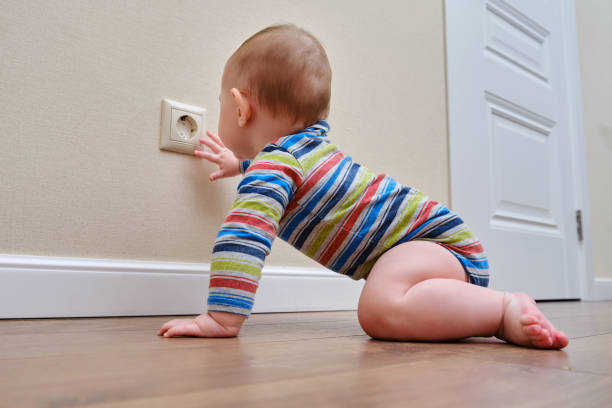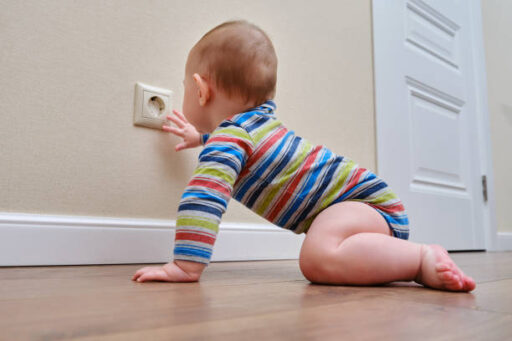Ah, the joys of parenthood! That’s like a roller coaster ride – exciting, sort of scary, and definitely full of unpredictability. The one time you get delighted looking at your cute baby suddenly turns into the chilling time of trying to catch them from reaching out for a power socket. I’m telling you, you are not the only person that has been there, done that! Baby proofing your home is a rite of passage for every parent, and today we’re diving into one of the most crucial areas: cord safety. As people who are passionate about what we do, the best way to go is to come along and let’s get the work done!

Understanding the Risks
Before we go any further, it is high time we discussed the significance of baby proofing cords first. Picture this: Your baby slowly progresses, moving on his or her tummy, looking at the world around with such fascination. All of a sudden they notice that juicy cord hanging from that lamp. Suddenly they pull on it as if this is some sort of cotton candy at the carnival. Yikes!
- Strangulation Hazards: Long cords pose a threat to a child’s life because they can form a loop around a child’s neck.
- Electrical Shock: The cords must be either pulled by the children or something may be stuck into the outlets.
- Tripping Hazards: Loose cords can cause falls.
- Damage to Cords: Pulling or biting can cause the wires to appear and if touched will cause a burn.
Understanding these risks makes it easier for you to ensure that your child is protected, or the environment is made safer.
Step 1: Assess Your Space
Well that’s enough of the horror, let’s get back to basics What basic needs must we sort out in order to sustain life on this planet? Begin with the basic assessment of your own home. Cord is kind of like clues to a detective on a mission – that’s what you should imagine. Look for areas with cords, such as:
- Dining rooms (refrigerators, ovens, microwave, dishwasher)
- monitors, printers, scanners and other operative equipment based at home offices.
- Kitchens (appliances)
- Bedrooms (lamps, chargers)
Grab a sheet of paper and paper pencil and list all the cords you come across. Determine which part require attention first. You will feel that you are the superhero managing your territory!
Step 2: Use Cord Shorteners and Organizers
There is no circumventing the wires and cords, a good way to baby-proof is to baby-proof the cords is through the use of cord shortenings. These convenient little contraptions erase the visibility of cords in the ways that a magic wand erases the sight of unwanted objects. They assist in some extent in cutting down of length features and prevent entanglements. Here are some options:
- Cord Shorteners: These handy gizmos conveniently allow users to fine tune the cord lengths.
- Cable Ties: Consider these as tiny superheroes that manage and contain a number of cords in one.
- Cord Covers: These protective sleeves minimize cords length and cover them to avoid attraction by little hands.
By tidying and shortening cables, you hide them and minimize the chances something negative happens. It’s like telling your cords to go on a diet in the most literal sense imaginable – less is more!
Step 3: Install Cord Protectors
For added safety, consider using cord protectors. These products shield cords from damage and keep tiny fingers away. Here are some popular options:
- Rubber Cord Covers: These lay flat on the floor and protect against tripping while concealing cables.
- Plastic Cord Channels: Mount these along walls to keep cords out of sight.
- Flexible Coil Wraps: These wrap around multiple cables at once, keeping them bundled like a well-behaved puppy.
Investing in cord protectors significantly reduces risks associated with exposed wires. It’s like putting your cords in a cozy little blanket!
Step 4: Secure Power Strips
Let’s not forget about power strips—they can be just as dangerous as loose cords! Here’s how to secure them:
- Power Strip Covers: Use covers that enclose power strips and prevent access.
- Mount Power Strips High: If possible, install power strips out of reach—ideally above furniture or on walls.
- Unplug Unused Devices: Keep power strips free from unnecessary devices that could tempt little hands.
These steps minimize access to potentially hazardous power sources. Remember, out of sight means out of mind!
Step 5: Teach Electrical Safety
While physical barriers are essential, educating your child about electrical safety remains crucial. Start teaching simple rules early on:
- No Pulling on Cords: Explain that tugging on cords can lead to accidents—like pulling a thread on an old sweater!
- Stay Away from Outlets: Teach them that outlets are off-limits unless supervised by an adult.
- Respect Appliances: Encourage them not to touch appliances without permission—think of it as teaching them to respect their elders!
Reinforcing these lessons helps instill caution as they grow. It’s never too early to start building good habits!
Step 6: Regularly Inspect Your Setup
Baby proofing doesn’t end after one round; it requires ongoing vigilance. Make it a habit to regularly inspect your home for new hazards:
- Check for frayed or damaged cords that may need replacing.
- Ensure all cord covers and protectors remain securely in place.
- Reassess your baby proofing strategies as your child grows more mobile.
By staying proactive, you adapt your safety measures as needed. Think of yourself as the guardian of safety in your home!
The following articles are related to baby’s comfort. It could be helpful for you.
How to calm your baby in a car seat
Tricky solution – How long do babies stay in newborn clothes
7 Genius Hacks: How To Keep Baby Warm In Car Seat
Final Thoughts
Taking these steps may seem challenging at first, but they prove necessary for peace of mind. Your child’s safety is worth every effort you make. Stay informed and proactive about baby proofing in your home! Remember, parenting revolves around learning—and sometimes laughing—along the way! With these precautions in place, you can enjoy peace of mind while watching your child explore their world safely!
Conclusion
Baby proofing cords proves vital for creating a safe environment for your little one. By understanding the risks and implementing effective strategies—like using cord shorteners, protectors, and teaching safety rules—you significantly reduce accidents in your home. Safety remains an ongoing process; stay vigilant and continually assess your surroundings as your child grows.






